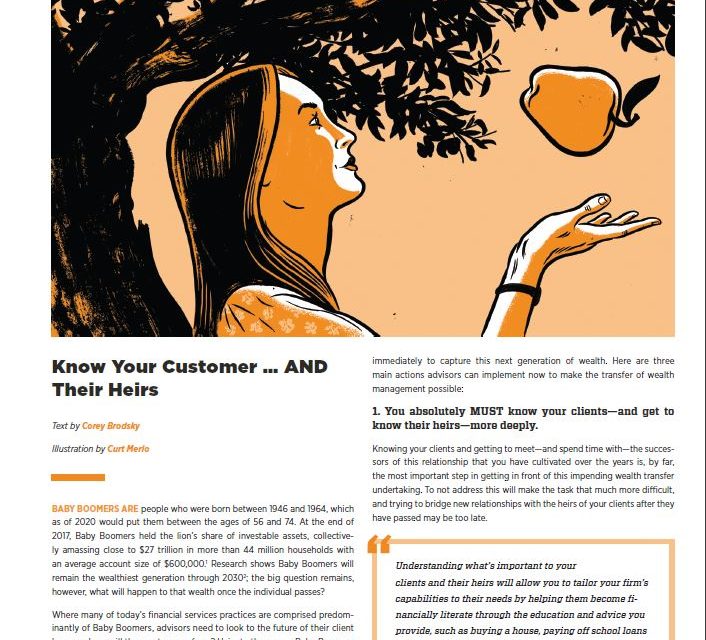
FREE 14.2 Views – Know Your Customer… and Their Heirs
Where many of today’s financial services practices are comprised predominantly of Baby Boomers, advisors need to look to the future of their client base … where will the assets come from? Heirs to those very Baby Boomers could be a possibility, but has the advisor brought the heir into the fold, making them feel as if they are also a valued client? Advisors should act immediately to capture this next generation of wealth. Here are three main actions advisors can implement now to make the transfer of wealth management possible.
To view the full article please register below:
FREE 14.2 Views – Know Your Customer… and Their Heirs
Baby Boomers are people who were born between 1946 and 1964, which as of 2020 would put them between the ages of 56 and 74. At the end of 2017, Baby Boomers held the lion’s share of investable assets, collectively amassing close to $27 trillion in more than 44 million households with an average account size of $600,000.1 Research shows Baby Boomers will remain the wealthiest generation through 20302; the big question remains, however, what will happen to that wealth once the individual passes?
Where many of today’s financial services practices are comprised predominantly of Baby Boomers, advisors need to look to the future of their client base … where will the assets come from? Heirs to those very Baby Boomers could be a possibility, but has the advisor brought the heir into the fold, making them feel as if they are also a valued client? Advisors should act immediately to capture this next generation of wealth. Here are three main actions advisors can implement now to make the transfer of wealth management possible:
1. You absolutely MUST know your clients—and get to know their heirs—more deeply.
Knowing your clients and getting to meet—and spend time with—the successors of this relationship that you have cultivated over the years is, by far, the most important step in getting in front of this impending wealth transfer undertaking. To not address this will make the task that much more difficult, and trying to bridge new relationships with the heirs of your clients after they have passed may be too late.
Here are some ways to draw the next generation of clients into the mix immediately:
- Keep track of any information you obtain about the heirs from your clients. Having the basics such as birthdays and contact information is imperative.
- Invite client’s children into the conversation during your face-to-face meetings so all may be addressed together. The younger generation will not only appreciate being included in matters concerning their parents, but this will also give them an opportunity to see your style of management and get a sense of what you could offer them.
- Once a rapport is established, broach a discussion with your clients about working with the children directly to manage their investable assets. Once you have permission to have an independent relationship with the children or benefactors, talk to them about their goals and the future. Furthermore, if possible, assign them to those within your office structure who are similar in age, as they may relate better to their current status in life.
- Host events geared towards younger beneficiaries at venues such as sporting events, restaurants or local establishments to interact with them in a more informal setting. The goal is to create a foundation with the heirs and grow the relationship; in order to accomplish this, the interaction must be on a regular basis.
2. Make yourself an invaluable resource.
This next step can only be achieved if you’ve successfully mastered getting past the surface and really getting to know your clients and their successors well; this includes not only understanding clients’ investment decisions, but also their priorities and values, business and professional insights, personal background and interests, and more.3 Understanding what’s important to your clients and their heirs will allow you to tailor your firm’s capabilities to their needs by helping them become financially literate through the education and advice you provide, such as buying a house, paying off school loans or becoming debt-free, just to name a few. In addition, you can also set them up with other needed professional networks, like tax preparation, insurance and legal advice. The goal is to become a constant, invaluable and irreplaceable resource for the client.
3. Increase your adoption of technology.
Studies show that 95 percent of consumers think it important for advisors to be tech-savvy and incorporate the latest and greatest technology tools into their practice.4 With every passing generation, from Baby Boomers to GenXers, followed by Millennials, the importance of technology is everincreasing. Only 25 percent of Baby Boomers are interested in additional tech services from their financial advisor, while a startling 53 percent of GenX millionaires claim they would leave their advisor if technology was not being used to enhance services.5
Advisors need to appeal to and satisfy the growing dependency on tech tools by today’s younger generation and potential investing clients; in order to do this, advisors have to continue to increase their adoption of technology. Whether it is implementing a CRM like Redtail and Salesforce in one’s practice to keep track of pertinent client information, or video conferencing using tools like Microsoft Teams or GoToMeeting to allow for remote meetings, technology is quickly becoming a must-have for clients when working with their investment professionals.
At the end of the day, most clients are firing their parents’ financial representatives of record after receiving their inheritances because advisors haven’t taken the time to get to know the beneficiaries. From personal experience, I can attest to this after losing my own parents. By starting to ask questions of your existing clients now and making a conscious effort to get to know the heirs, you can significantly raise the chances of retaining assets when clients die and pass on their estate to others.
Sources:
1. Cerulli Associates. (2019). The Neglected Generation. Retrieved from http://info.cerulli.com/rs/960-BBE-213/images/Cerulli-HNW-Generation-X-2019.pdf
2. American Bankers Association. (2017, January 31). Banking the Boomers Infographic. Retrieved from ABA Foundation: https://www.aba.com/news-research/research-analysis/banking-boomers
3. OppenheimerFunds. (2016, May 27). How to Build a Professional Practice. Retrieved from CEO Advisor Institute Programs: https://advisorhub.com/wp-content/uploads/2013/07/CEO-Advisor-Program-Overview-Final.pdf
4. Million Dollar Round Table. (2018, November). Study Conducted Online by Can Fintech And Human Financial Advisors Coexist?
5. CNBC. (2019, May 8).5 Must-Have Tech Tools for Financial Advisors. Retrieved from Investor Place: https://investorplace.com/2019/05/5-must-tech-tools-financial-advisors/
Please reference disclosures: https://blog-dev.americanportfolios.com/disclosures/












